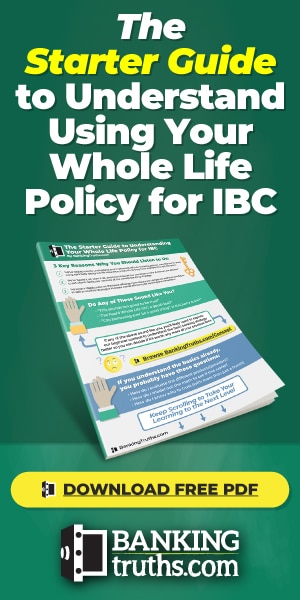How Soon Can I Take A Loan From A Policy Designed For Infinite Banking?
I want to answer a question that I get a lot which is, “If I start over funding a whole life policy to be my private banking engine, when can I actually start using it for purchases?”.
Now those of you that went through the original Banking Truths three-part video course probably remember the “Pants” portion in the second video. Since I’m in California I’m going to draw them as shorts.
Not very stylish ones, but in this pocket nonetheless it would be a whole life policy. In this pocket would be your traditional banking mechanism, whether that’s checking, savings, CDs, money market, whatever it is. And I find that my clients do have a decent amount saved up in reserves simply for liquidity use and control and safety.
And unfortunately for that tradeoff, they’re not going to get a lot of interest credited to their money. What will happen if they do get any interest is they’ll pay ordinary income tax on that income. And also if they’re supporting a family usually they’re paying something in the way of term insurance that doesn’t build any equity or have any growth at all.
Now simply by taking some of this liquidity and safety money and putting it into another vehicle which is historically very safe and can be structured to be very liquid. You have to do it for at least five years, but if you just move some of this money from one pocket to another pocket what you’re going to do is you’re going to create a very nice compounding engine for a nice banking mechanism.
Over time you’ll probably find that you do get a much better rate of return. There won’t be any tax due on the growth or the distributions if you keep the policy in force, and you’ll need less or no term insurance depending on how big of a banking policy you set up.
What we’re gonna do is we’re gonna take this hypothetical model and we’re going to look at an actual whole life illustration that’s structured to do just that. This is an actual illustration for a 45 y45-year-old using the 2015 dividend scales and they are not guaranteed (although this company has paid them for well over 100 years as of all the companies that we recommend). Although dividends will change, keep in mind that dividends which are largely tied to interest rates are historically very low and there’s a good chance that they can go up in the future.
Now with that out of the way let’s go ahead and take a look at this illustration in the context of the “Pants”. There’s really only two columns here that we’re going to focus on and that would be the total net outlay which is your premium and the total year-end cash value.
If we see that this 45-year-old gentleman wants to put in thirty-five thousand dollars, by the way, don’t get attached the dollar amount – let’s just focus on the percentage. If he puts that over here and by the end of the year, in today’s low-interest rate environment, he has twenty-seven thousand dollars over that. That’s actually over 78 percent of his cash value is available by the end of Year 1.
One of the things I bring up is, when clients do have significant money in savings and I ask them when’s the last time you tapped 75 percent of your savings account, the answers usually never. You know they usually keep something in reserves.
With that in mind let’s just go ahead and take a look at how much of a percentage we have each and every year. If we look at year 2, the seventy thousand dollars have gone in and there’s access to fifty-six, over fifty-six thousand dollars that’s actually over eighty-one percent of your cash value.
By year five notice that one hundred seventy-five thousand dollars has gone in and really there’s almost one hundred seventy-five thousand sitting right there in cash value.
I think that’s really important to notice that you will have a sufficient amount of liquidity out of the gate – not total. But when I ask clients what they’re doing with their current savings account they rarely need total liquidity anyway and let’s not forget that by agreeing to not have total liquidity to these funds in the early years you’re going to get two things for your money in return.
For one is you’re gonna have a substantially better mechanism to grow your money going forward which we’re gonna look at in just one moment. But let’s not forget this part: I don’t know any other savings account that if you were to die and have anywhere from 35 to one hundred seventy-five thousand dollars they’d pay your family one point two to one point four tax-free if you were to pass away.
I want to look at this together. Let’s take a look at where after our break even and let’s just round up and say that this is our break-even point the 174, 174 plus thirty-five thousand a premium.
Let’s see what kind of output we get. What kind of rate of return we get on those inputs. Let’s do this together.
174811 plus thirty-five thousand dollars of premium. Now it’s two hundred nine thousand eight hundred eleven dollars. Now notice we have two hundred nineteen thousand so if I multiply the two hundred nine eight eleven that we have in there times 1.044, basically saying that we’re gonna get 4.4 percent.
Notice how this figure here, 219042, is smaller than this figure here the 219062. So I don’t know any banking mechanism in this environment right now that’s going to give you 4.4 percent not to mention a banking mechanism that’s going to say, “You know I have a special deal with the government because we take care of widows and orphans where you don’t get taxed on the growth of your money”.
Let’s just take it down to, let’s go all the way down to the last column down here because it gets better and better every year. Let’s take a look down here because this policy gets better and better every year. If we take this 743549 plus our thirty-five thousand dollars of premium which, by the way, you don’t need to pay at this point – you could stop paying premiums but if you have a mechanism that does this why would you want to stop.
It’s saying we should have 778 549 but you can see here that we have 819. If we take this and multiply it by 1.052 basically simulating that we’re gonna get 5.2 percent.
Notice how this figure is still smaller than that. A friend of mine explained this to me really well and the reason why the policy gets more efficient is it’s like a jet airplane that takes off from say Los Angeles to New York and it’s just full of fuel so it’s not going to be as efficient as later on when it gets from say Pennsylvania and New York.
Because what happens is a lot of the fuel is burned off. So the plane’s gotten more efficient and the same thing is happening inside this policy where the mortality charges are burning off and you’re getting mostly growth.
OK, so let’s go ahead and bring it back full circle to “When can I start using the money in my policy?”.
Well, just like you could take the money out of this pocket at any time. So can you also utilize the funds in your cash surrender column. And even though there is somewhat restricted access early on, it’s fairly nominal compared to what you’re probably going to need if you are indeed starting one of these policies and you can withdraw everything you see here in this column at any time for any reason.
However, you’re going to see in future videos that there are advantages to utilizing the loan feature and to borrowing against this fund and to keep it compounding.
The simple reason is if you have a mechanism that compounds steadily and safely at a very nice clip without any taxation going on. If you borrow against that and then you go ahead and pay back the loan, well you don’t lose your place in line on this curve and you can keep using it and again and again rather than killing the goose that will continue to lay golden eggs.
Click here to schedule a call with us to take a deeper dive into this banking concept to help you understand how this could look for your situation going forward.

John “Hutch” Hutchinson, ChFC®, CLU®, AEP®, EA
Founder of BankingTruths.com

